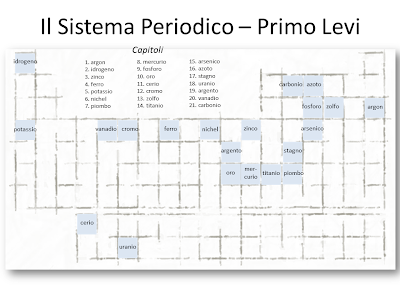
The Periodic Table (1975) is a collection of fascinating stories by the Italian chemist and novelist Primo Levi (1919 – 1987). The collection, titled in Italian as Il sistema periodico, was translated into English in 1985. Each of the 21 chapters is based on an element that sometimes playing a figurative role in the story, but most often, playing a literal role. The majority of the stories are based on events in Levi’s life. In chapter 10, Gold, Levi is captured by the Fascists. In chapter 11, Cerium, Levi is in Auschwitz. How the elements gold and cerium figure into the stories is Levi’s narrative magic. Another important work by Levi is Se questo è un uomo (If This is a Man) which describes his 11 months in the Auschwitz and more generally the human condition in all its extremes.
The periodic table is the organizional scheme of how we understand elements and their relationships. It’s clever and in hindsight it makes sense, that Levi, a chemist, chose this title of the collection as such and structured each story around an element. Throughout the book it’s clear that Levi is a probing mind, a detective in matters of life and science, and in a battle with nature to unlock its secrets. To Levi, “incomprehensible matter” must be examined, writing that “[w]e must never feel disarmed: nature is immense and complex, but it is not impermeable to the intelligence; we must circle around it, pierce and probe it, look for the opening or make it.” There are many passages in the book where battle metaphors are used.
In the stories, there are many instances when Levi starts with an observation or fact about life or chemistry and generalizes it in a matter-of-fact way to a quasi-mediation on life. A good example is from chapter 3, Zinc, where Levi goes from a specific chemical behavior of zinc to wondering about the Fascist mentality:
The course notes contained a detail which at first reading had escaped me, namely, that the so tender and delicate zinc, so yielding to acid which gulps it down in a single mouthful, behaves, however, in a very different fashion when it is very pure: then it obstinately resists the attack. One could draw from this two conflicting philosophical conclusions: the praise of purity, which protects from evil like a coat of mail; the praise of impurity, which gives rise to changes, in other words, life. I discarded the first, disgustingly moralistic, and I lingered to consider the second, which I found more congenial. In order for the wheel to turn, for life to be lived, impurities are needed, and the impurities of impurities in the soil, too, as is known, if it is to be fertile. Dissension, diversity, the grain of salt and mustard are needed: Fascism does
not want them, forbids them, and that’s why you’re not a Fascist; it wants everybody to be the same, and you are not.
One aspect that you get a sense of reading these stories is Levi’s love of the origin of words and their meaning. The collection starts out in Chapter 1, Argon, with Levi relating what he knows of his ancestors, part of the larger Jewish community in Piedmont first arriving there in 1500. In the backstory, Levi introduces many Jewish-Piedmontese terms from his childhood. His ancestors to him were like argon, a noble gas, inert in that they never really mixed with other elements/society – or at least seemed relegated to the margins of society. Another example of his love of words is from chapter 6, Nickel, where Levi writes:
The entrails of the earth swarm with gnomes, kobolds (cobalt!), nickel, German “little demon” or “sprite,” and from which we derive the word nickel, creatures who can be generous and let you find a treasure beneath the tip of your pickax, or deceive you and bedazzle you, making modest pyrites glitter like gold, or disgusting zinc in the garb of tin: and in fact, many are the minerals who names have roots that signify ‘deception, fraud, bedazzlement.’The collection ends with the story that seems to have been the nucleus for Levi’s writing career. He alludes that that story was “dreamed in an hour and place when my life was not worth much” – probably while imprisoned. It is the story of a carbon atom and this story is perhaps the most beloved of the 21 stories. This story appeared in The Oxford Book of Modern Science Writing and is what led me originally to The Periodic Table.

Nice!
ReplyDelete